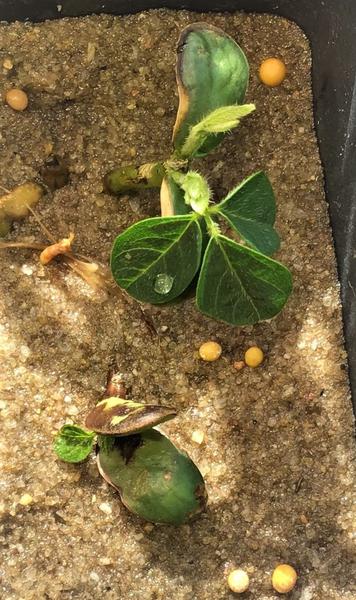Carfentrazone Injury
- Type
- Physiological
- Leaf Condition
- Leaf Spot
- Leaf Location
- Entire, Mature
- Field Distribution
- Edges
- Prior Environmental
- Organic Soil, Wind
- Season
- Early Vegetative
- Cropping System
- Soybean Followed By Soybean, Conventional Till, Reduced Till
Symptoms
Protoporphyrinogen oxidase (PPO)-inhibiting herbicides (herbicide group [HG] 14) inhibit the production of chlorophyll. PPO-inhibiting herbicides minimally translocation through plants, thus the injury will only occur where the spray droplets come into contact with the soybean plant. Injury incurred by PPO-inhibiting herbicides applied pre-emergence includes necrosis on the margins of cotyledons and leaves (Figure 1). Injury can occur via having treated-soil water-splashed onto the emerging plant or contact with the herbicide in the soil-water as the plant emerges. Soybeans injured by PPO-inhibiting herbicides applied pre-emergence can result in plant death if the hypocotyls are chemically-excised. Injury incurred by PPO-inhibiting herbicides applied post-emergence includes speckled-necrosis and plant stunting. The development of PPO-inhibiting herbicide injury will be rapid and injury will be greater on hot, humid days. The injury caused by PPO-inhibiting herbicides on soybeans will subside with 7 to 14 days after application. Labeled rotation restrictions should be followed to ensure that crops following soybeans are not injured by carryover of PPO-inhibiting herbicides.
Management
Labeled rotation restrictions should be followed to ensure that crops following soybeans are not injured by carryover of PPO-inhibiting herbicides. Physical drift can be avoided by spraying when .the average wind speed is less than 10 miles an hour and mid-day or –afternoon to avoid a temperature inversion



